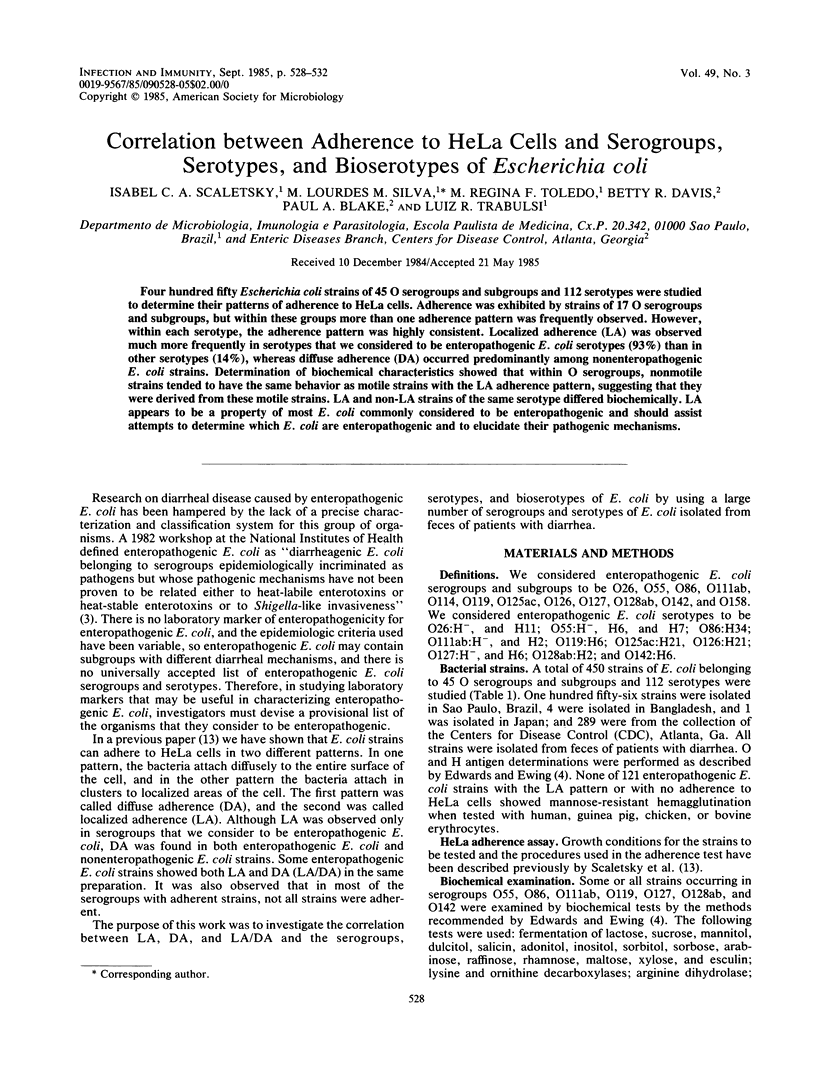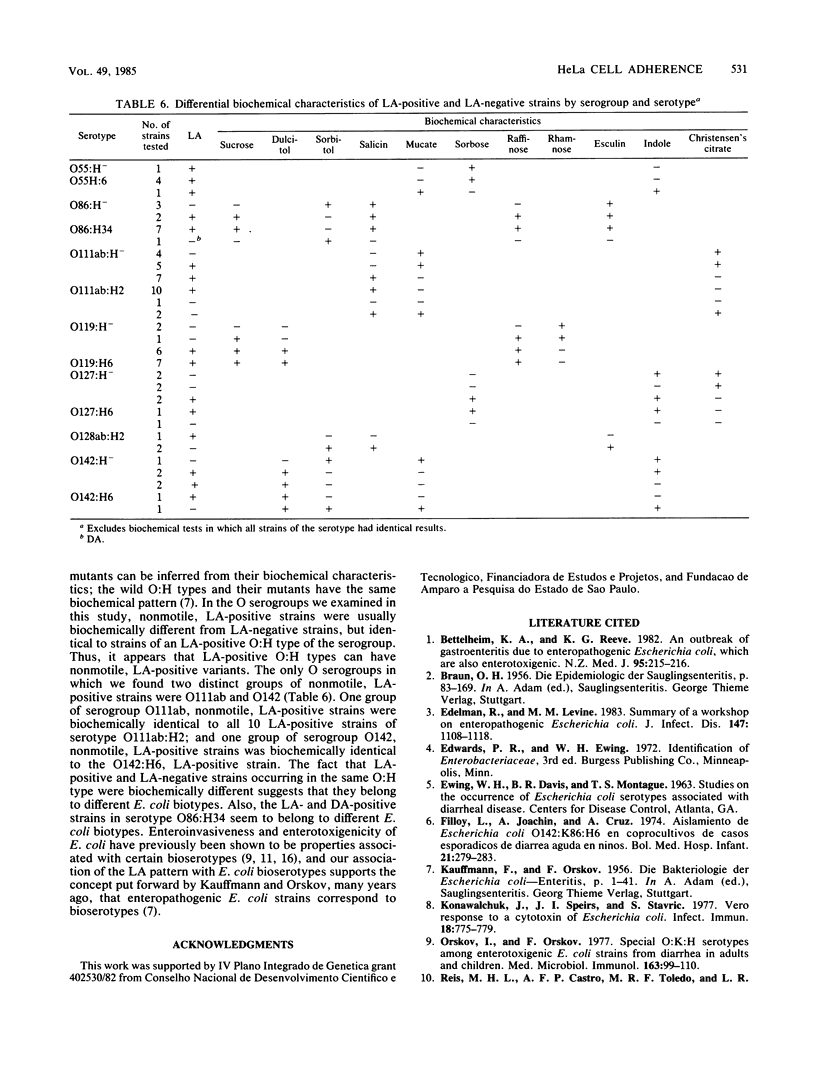Abstract
Four hundred fifty Escherichia coli strains of 45 O serogroups and subgroups and 112 serotypes were studied to determine their patterns of adherence to HeLa cells. Adherence was exhibited by strains of 17 O serogroups and subgroups, but within these groups more than one adherence pattern was frequently observed. However, within each serotype, the adherence pattern was highly consistent. Localized adherence (LA) was observed much more frequently in serotypes that we considered to be enteropathogenic E. coli serotypes (93%) than in other serotypes (14%), whereas diffuse adherence (DA) occurred predominantly among nonenteropathogenic E. coli strains. Determination of biochemical characteristics showed that within O serogroups, nonmotile strains tended to have the same behavior as motile strains with the LA adherence pattern, suggesting that they were derived from these motile strains. LA and non-LA strains of the same serotype differed biochemically. LA appears to be a property of most E. coli commonly considered to be enteropathogenic and should assist attempts to determine which E. coli are enteropathogenic and to elucidate their pathogenic mechanisms.
Full text
PDF




Selected References
These references are in PubMed. This may not be the complete list of references from this article.
- Bettelheim K. A., Reeve K. G. An outbreak of gastroenteritis due to enteropathogenic Escherichia coli, which are also enterotoxigenic. N Z Med J. 1982 Apr 14;95(705):215–216. [PubMed] [Google Scholar]
- Edelman R., Levine M. M. From the National Institute of Allergy and Infectious Diseases. Summary of a workshop on enteropathogenic Escherichia coli. J Infect Dis. 1983 Jun;147(6):1108–1118. doi: 10.1093/infdis/147.6.1108. [DOI] [PubMed] [Google Scholar]
- Filloy L., Joachin A., Cruz A. Aislamiento de Escherichia coli 0142:K86:H6 en coprocultivos de casos esporádicos de diarrea aguda en niños. Bol Med Hosp Infant Mex. 1974 Mar-Apr;31(2):279–283. [PubMed] [Google Scholar]
- Konowalchuk J., Speirs J. I., Stavric S. Vero response to a cytotoxin of Escherichia coli. Infect Immun. 1977 Dec;18(3):775–779. doi: 10.1128/iai.18.3.775-779.1977. [DOI] [PMC free article] [PubMed] [Google Scholar]
- Orskov I., Orskov F. Special O:K:H serotypes among enterotoxigenic E. coli strains from diarrhea in adults and children. Occurrence of the CF (colonization factor) antigen and of hemagglutinating abilities. Med Microbiol Immunol. 1977 Jul 18;163(2):99–110. doi: 10.1007/BF02121825. [DOI] [PubMed] [Google Scholar]
- Reis M. H., Castro A. F., Toledo M. R., Trabulsi L. R. Production of heat-stable enterotoxin by the O128 serogroup of Escherichia coli. Infect Immun. 1979 Apr;24(1):289–290. doi: 10.1128/iai.24.1.289-290.1979. [DOI] [PMC free article] [PubMed] [Google Scholar]
- Reis M. H., Matos D. P., de Castro A. F., Toledo M. R., Trabulsi L. R. Relationship among enterotoxigenic phenotypes, serotypes, and sources of strains in enterotoxigenic Escherichia coli. Infect Immun. 1980 Apr;28(1):24–27. doi: 10.1128/iai.28.1.24-27.1980. [DOI] [PMC free article] [PubMed] [Google Scholar]
- Sack R. B. Human diarrheal disease caused by enterotoxigenic Escherichia coli. Annu Rev Microbiol. 1975;29:333–353. doi: 10.1146/annurev.mi.29.100175.002001. [DOI] [PubMed] [Google Scholar]
- Scaletsky I. C., Silva M. L., Trabulsi L. R. Distinctive patterns of adherence of enteropathogenic Escherichia coli to HeLa cells. Infect Immun. 1984 Aug;45(2):534–536. doi: 10.1128/iai.45.2.534-536.1984. [DOI] [PMC free article] [PubMed] [Google Scholar]
- Scotland S. M., Day N. P., Cravioto A., Thomas L. V., Rowe B. Production of heat-labile or heat-stable enterotoxins by strains of Escherichia coli belonging to serogroups O44, O114, and O128. Infect Immun. 1981 Jan;31(1):500–503. doi: 10.1128/iai.31.1.500-503.1981. [DOI] [PMC free article] [PubMed] [Google Scholar]
- TRABULSI L. R., MANISSADJAN A., PENNA H. A., LIBERATORE R., DUAILIBE L., de CAMARGO, PEIXOTO E. S. [Infantile diarrhea caused by enteropathogenic colibacilli. Preliminary studies on the occurrence of certain groups and serological types in Sao Paulo]. Rev Inst Med Trop Sao Paulo. 1961 Nov-Dec;3:267–270. [PubMed] [Google Scholar]
- Toledo M. R., Alvariza M. do C., Murahovschi J., Ramos S. R., Trabulsi L. R. Enteropathogenic Escherichia coli serotypes and endemic diarrhea in infants. Infect Immun. 1983 Feb;39(2):586–589. doi: 10.1128/iai.39.2.586-589.1983. [DOI] [PMC free article] [PubMed] [Google Scholar]
- Toledo M. R., Trabulsi L. R. Correlation between biochemical and serological characteristics of Escherichia coli and results of the Serény test. J Clin Microbiol. 1983 Mar;17(3):419–421. doi: 10.1128/jcm.17.3.419-421.1983. [DOI] [PMC free article] [PubMed] [Google Scholar]
- Ulshen M. H., Rollo J. L. Pathogenesis of escherichia coli gastroenteritis in man--another mechanism. N Engl J Med. 1980 Jan 10;302(2):99–101. doi: 10.1056/NEJM198001103020207. [DOI] [PubMed] [Google Scholar]


